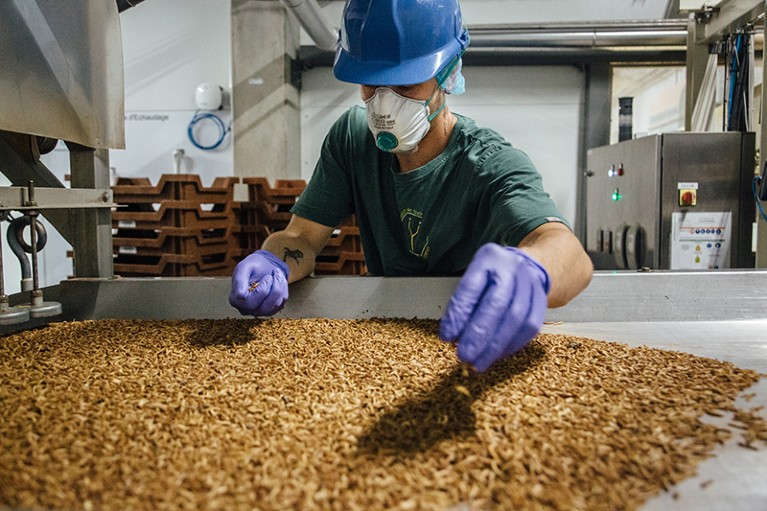
The French firm Ÿnsect in Dole grows mealworm larvae into beetles for use in oil, protein sources and fertilizer.Credit: Cyril Marcilhacy/Bloomberg via Getty
Walking into Ÿnsect’s flagship manufacturing site in Dole, eastern France, the first thing that visitors are met with is a hot, earthy, composting smell. With it comes the realization that this is not a typical factory. At 17 metres high, this is the world’s largest vertical insect farm — home to at least 3 trillion mealworm beetles (Tenebrio molitor).
The company’s chief executive and co-founder, Antoine Hubert, says that the beetles have a good life, as far as being an insect goes. Each of their stacked plastic trays is kept at an optimal 60% humidity and a balmy 25–27 °C. Nutrition, growth and moisture levels are all recorded for analysis, and human visitors are allowed to inspect the trays only from a distance — to prevent contamination of this prized ecosystem.
The beetles are raised in this way from larvae to adult, at which point they meet a quick death in steam before being harvested into oil, protein and fertilizer.
Will cell-based meat ever be a dinner staple?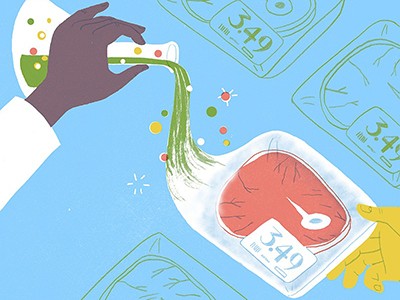
Insects have come under the spotlight over the past few years, as scientists seek alternative sources of protein to feed the rapidly expanding global population. A direct nutritional comparison shows that edible insect species have greater protein potential than do conventional meat products — 100 grams of mealworm larvae produces 25 g of protein, whereas 100 g of beef contains 20 g of protein1. Insects also have a high food-conversion ratio when compared with livestock. To produce the same amount of protein, for example, crickets require around six times less feed than do cattle, four times less than sheep, and half that of pigs and chickens2. But various attempts by companies to market insects as a mainstream food source in Europe and North America have fallen flat and largely been dismissed as a fad. And some researchers have concerns about the effects on the environment, ranging from whether escaped insects might disrupt local ecosystems to the impact of insect ‘factories’.
So why farm insects at all? “The world is facing a huge food sustainability crisis,” explains Hubert, an environmental engineer. “Insect protein is one very realistic and obvious solution to mitigating some of those challenges,” he says.
A burger for your burger
With the global population expected to reach almost 10 billion by 2050, United Nations forecasters have warned that food production will also need to increase by as much as 70%.
However, because mealworm burgers are, at the moment, unlikely to sell out in your local supermarket, Ÿnsect grows insects for animal feed. This is given to fish, pigs and poultry, taking the pressure off conventional agricultural land use.
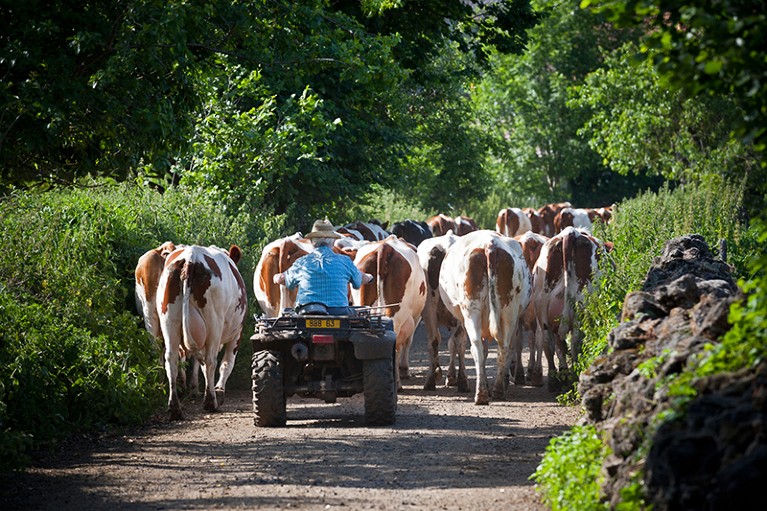
Cattle farming is a target for emissions-reductions measures.Credit: Emmanuel Lattes/Alamy
The use of vertical farming has grown rapidly over the past few years, spurred on, in part, by advances in LED lighting, the cost of which fell by 94% between 2008 and 2015. Several start-ups (including Infarm in Berlin and Aerofarms in Newark, New Jersey) use the system to produce vegetables such as lettuce for human consumption. And the global market of the vertical-farming industry is expected to grow from US$3.7 billion in 2021 to $10.5 billion in 2026.
Meanwhile, sales of plant-based alternatives to meat that are designed to reduce the demand for cattle farming — an industry responsible for 65% of all livestock emissions — seem to be stalling. When meat-substitute company Beyond Meat in El Segundo, California, went public on the stock market in 2019, its share price rose by 163%. But after the initial excitement, sales slowed, and they have remained about the same since 2020.
Gut feeling: building a picture of Latin American microbiomes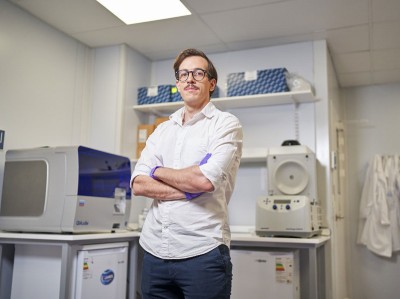
Other companies also seem to be experiencing a slowing of sales. Marlow Foods in Stokesley, UK, which produces the plant-based brands Quorn and Cauldron, reported a 4.8% drop in revenues in 2021. Meanwhile, in the United States, plans to roll out plant-based burgers at the fast-food giant McDonalds were quietly shelved at the start of last year (the ‘McPlant’ is still available in the United Kingdom and some other countries).
For now, it seems the desire to reduce carbon footprints has been overtaken by a love of meat. So, could feeding insects to the animals that produce the meat be a solution? Ÿnsect thinks so and says its system is easily scalable.
Over the past decade, the company has grown to become a world leader in breeding mealworms, a practice that it calls molityculture. Ÿnsect’s Dole site has the capacity to produce more than 1,000 tonnes of insect product per year, while using 98% less land and 50% fewer resources than is currently the case for conventional livestock farming, according to the company. A 2022 study3 suggests that incorporating insects into European diets could reduce water and land use by more than 80%.
The Dole site is the first and largest of its kind, but it will soon be dwarfed by the opening of a site in Amiens, around 100 kilometres north of Paris.
And in March, the company announced the acquisition of commercial mealworm farm Jord Producers in Lindsay, Nebraska — manufacturing the mealworms into Ÿnsect products is due to start at the end this year. Hubert aims to open 15 more plants by the end of the decade. By that time, he anticipates, the company will focus equally on protein for human consumption and for animal feed.
Competition is growing in the insect-farming field. Another French company, nextProtein in Paris, was founded in 2015. Like Ÿnsect, nextProtein wants to tackle the protein gap in animal feed, but it grows black soldier flies (Hermetia illucens) to produce its ground protein product.
What humanity should eat to stay healthy and save the planet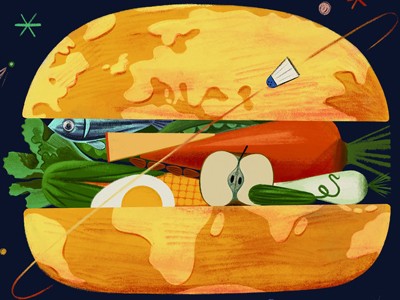
It chose these flies because of their fast-growing larvae — which can increase in size by 10,000 times in the space of 3 weeks — and their resilience to various conditions. Furthermore, the insects are also fed fruit and vegetables that would ordinarily end up in landfill. The nextProtein operation is small but efficient, producing as much protein in 100 square metres as a soya-bean farm does in 100 hectares.
But the huge growth rates of black soldier flies and mealworms might come with risks. “I’ve seen so many problems around the world with invasive species,” says Åsa Berggren, an ecologist at the Swedish University of Agricultural Sciences in Uppsala. “Today, there’s not much regulation on what insects you’re allowed to import. You can bring in insects that threaten local livelihoods and ecosystems if they escape from where they’re being farmed — and they do escape.”
Insect problems
It’s no coincidence that both Ÿnsect and nextProtein are based in France — as Hubert explains, there are clear advantages to doing this kind of work there. Notably, INRAE, France’s National Research Institute for Agriculture, Food and Environment, is the largest agricultural research institute in Europe, with an annual budget of €1 billion (US$1.1 billion) in 2021. “We are well supported here by public investment from funds like [French public investment bank] BPI, also in terms of government and administration,” Hubert says. “We also benefit from top-level French research with public and private institutes.”
But if the companies want to crack the French food market, they might find it difficult. In a country where just 2.2% of people say they are vegan, vegetarian or pescatarian, a strong meat lobby dominates, and campaigners have a tough time shifting public attitudes towards giving up meat.
“The meat lobby is one of the biggest barriers to the reduction of meat and dairy in France,” says Benoit Granier, a spokesperson for France’s Climate Action Network in Paris. “These groups spend millions on propaganda mass-media campaigns that convince people that they need to eat meat to be healthy,” he says.
Nature Outlook: Sustainable nutrition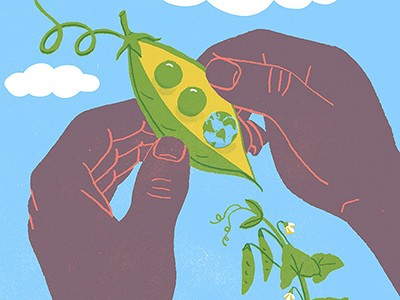
A Greenpeace report published last year included evidence of meat lobbyists targeting schools and coming into conflict with teachers and parents in the playground. And one farmers union once advocated for meat with the slogan, “To save a peasant farmer, eat a vegan”.
In 2020, meat consumption in France amounted to around 84.4 kilograms per person, with French households spending a total of almost €40 billion on meat.
Despite being home to the second largest population of livestock in Europe, France still imports large quantities of meat and offal — €4 billion worth in 2020 — from elsewhere in the European Union to meet demand. “So it’s not as if by buying meat alternatives you are hurting French farmers,” says Granier. The problem is that “the culture of traditional food is so strong”. In addition, “consumers think that purchasing meat is good for farmers, whereas in reality it is only profiting the meat industry”, he says.
As the EU’s leading producer of beef, France has arguably the most to do when it comes to reducing agriculture’s carbon footprint. Although insect farming helps to cut emissions by supplementing the feed of livestock such as pigs, chickens and fish, it can’t help to reduce cattle-farming emissions because cows eat only grass and dried grain.
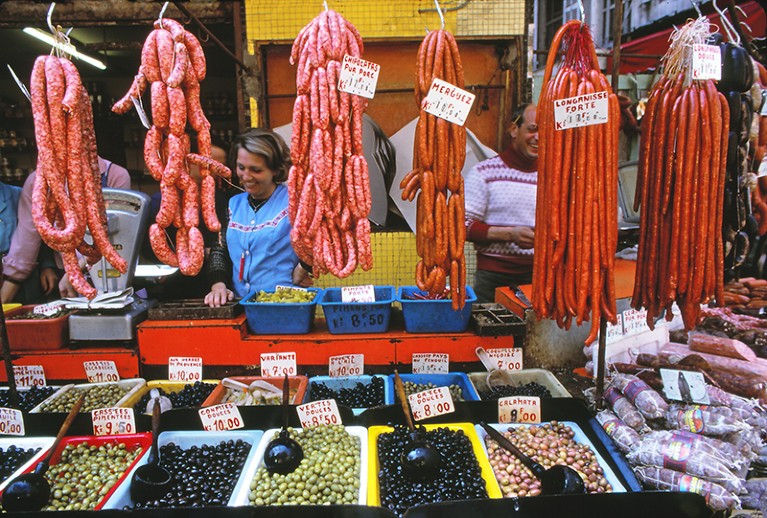
Meat products are in high demand in French food markets.Credit: Owen Franken/Getty
And the innovation landscape Hubert finds himself in is far from perfect. “The amount of European and French funding available for industrial and innovative projects like ours is not on the same level as in the United States — there the amount is much more significant,” he says.
Automation, alongside $425 million in global investment funding, has made Ÿnsect’s rapid growth possible. Robots manage stocks in much the same way they do in Amazon factories or large supermarket chains, but they are also able to measure the airflow and density of each tray to determine the growth rate and size of its inhabitants. And a heat-imaging technique gathers data on the contents of each tray, providing information on whether the insects have eaten recently, their moisture levels and other key determinants of health. “Studies have shown they like to be packed in with their mates — if you see a beetle on its own away from the crowd, it becomes anxious. It’s a biological tactic, safety in numbers,” Hubert explains.
Finish your meal
In 2022, Ÿnsect’s research arm, which has secured more than 341 patents, launched the world’s first industrial genomic selection programme dedicated to insect breeding. Through Ÿnfabre, Hubert’s team has sequenced the genomes of the mealworms it breeds to gain an understanding of what makes the optimum protein-producing beetle4.
The programme brings together researchers from different fields to develop phenotyping tools for identifying certain biological traits and genotyping techniques for identifying genomic variation. Hubert wants to develop the most effective model possible for breeding resilient insect lines, as well as to help further scientific understanding of insect proteins in general.
Nine ‘brain food’ tips for researchers
In the United States, the Center for Environmental Sustainability Through Insect Farming is in the process of being set up in College Station, Texas, with the aim of studying insect proteins for more efficient farming.
But Granier is pessimistic about the prospect of insect food denting carbon emissions. By supplying animal feed to farmers, he says, Ÿnsect’s products encourage the continuation of industrial livestock farming, even if it is to a lesser extent. “As long as you are still farming animals in an industrial way, you are creating issues like carbon emissions, pollution of the water and of the land,” he explains.
Berggren agrees there are lingering concerns. Unless you create a sustainable cycle, “you haven’t changed the food chain”, she says. “You’ve just put more animals in it.”
When it comes to shifting insect protein towards human consumption, Granier, too, advises caution: “I don’t think the public are there yet. And if you ask the environmental organizations and environmental NGOs in France, most of us don’t think insects are a viable solution. What we need is to encourage plant-based diets and to support farmers and food manufacturers that produce healthy and sustainable plant-based products,” he adds.
But Hubert says that something is better than nothing. “We know what we do is a good answer to climate and biodiversity collapse, the more people we can get on board, the better,” he says. “Insect farming is not the only solution, and there will need to be more. But we know we are reaching a tipping point in the climate crisis — so if we want to go quickly and make an impact, this is a fast and efficient way of doing it.”

 Will cell-based meat ever be a dinner staple?
Will cell-based meat ever be a dinner staple?
 What humanity should eat to stay healthy and save the planet
What humanity should eat to stay healthy and save the planet
 Nine ‘brain food’ tips for researchers
Nine ‘brain food’ tips for researchers








